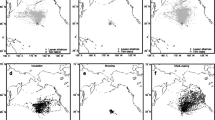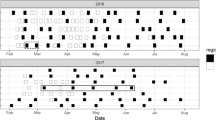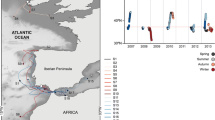Abstract
Electronic tagging and remotely sensed oceanographic data were used to determine the oceanographic habitat use and preferences of Atlantic bluefin tuna (Thunnus thynnus L.) exhibiting behaviors associated with breeding in the Gulf of Mexico (GOM). Oceanographic habitats used by 28 Atlantic bluefin tuna exhibiting breeding behavior (259 days) were compared with available habitats in the GOM, using Monte Carlo tests and discrete choice models. Habitat utilization and preference patterns for ten environmental parameters were quantified: bathymetry, bathymetric gradient, SST, SST gradient, surface chlorophyll concentration, surface chlorophyll gradient, sea surface height anomaly, eddy kinetic energy, surface wind speed, and surface current speed. Atlantic bluefin tuna exhibited breeding behavior in the western GOM and the frontal zone of the Loop Current. Breeding areas used by the bluefin tuna were significantly associated with bathymetry, SST, eddy kinetic energy, surface chlorophyll concentration, and surface wind speed, with SST being the most important parameter. The bluefin tuna exhibited significant preference for areas with continental slope waters (2,800–3,400 m), moderate SSTs (24–25 and 26–27°C), moderate eddy kinetic energy (251–355 cm2 s−2), low surface chlorophyll concentrations (0.10–0.16 mg m−3), and moderate wind speeds (6–7 and 9–9.5 m s−1). A resource selection function of the bluefin tuna in the GOM was estimated using a discrete choice model and was found to be highly sensitive to SST. These habitat utilization and preference patterns exhibited by breeding bluefin tuna can be used to develop habitat models and estimate the probable breeding areas of bluefin tuna in a dynamic environment.










Similar content being viewed by others
References
Arthur SM, Manly BFJ, McDonald LL, Garner GW (1996) Assessing habitat selection when availability changes. Ecology 77:215–227
Bakun A (1996) Patterns in the ocean: ocean processes and marine population dynamics. California Sea Grant College System, National Oceanic and Atmospheric Administration in cooperation with Centro de Investigaciones Biológicas del Noroeste, La Jolla
Baumgartner MF, Mate BR (2005) Summer and fall habitat of North Atlantic right whales (Eubalaena glacialis) inferred from satellite telemetry. Can J Fish Aquat Sci 62:527–543
Bayliff WH (1994) A review of the biology and fisheries for northern bluefin tuna, Thunnus thynnus, in the Pacific Ocean. FAO Fish Tech Pap 336/2:244–295
Block BA, Dewar H, Farwell C, Prince ED (1998a) A new satellite technology for tracking the movements of Atlantic bluefin tuna. Proc Natl Acad Sci USA 95:9384–9389
Block BA, Dewar H, Williams T, Prince ED, Farwell C, Fudge D (1998b) Archival tagging of Atlantic bluefin tuna (Thunnus thynnus thynnus). Mar Technol Soc J 32:37–46
Block BA, Dewar H, Blackwell SB, Williams TD, Prince ED, Farwell CJ, Boustany A, Teo SLH, Seitz A, Walli A, Fudge D (2001) Migratory movements, depth preferences, and thermal biology of Atlantic bluefin tuna. Science 293:1310–1314
Block B, Costa D, Boehlert G, Kochevar R (2002) Revealing pelagic habitat use: the Tagging of Pacific Pelagics program. Oceanol Acta 25:255–266
Block BA, Teo SLH, Walli A, Boustany A, Stokesbury MJW, Farwell CJ, Weng KC, Dewar H, Williams TD (2005) Electronic tagging and population structure of Atlantic bluefin tuna. Nature 434:1121–1127
Caton AE (1994) Review of aspects of southern bluefin tuna biology, population, and fisheries. FAO Fish Tech Pap 336/2:296–343
Chambers RC (1997) Environmental influences on egg and propagule sizes in marine fishes. In: Chambers RC, Trippel EA (eds) Early life history and recruitment in fish population. Chapman & Hall, New York, pp 63–102
Chesson J (1978) Measuring preference in selective predation. Ecology 59:211–215
Chesson J (1983) The estimation and analysis of preference and its relationship to foraging models. Ecology 64:1297–1304
Cooper AB, Millspaugh JJ (1999) The application of discrete choice models to wildlife resource selection studies. Ecology 80:566–575
Dietrich DE, Lin CA (1994) Numerical studies of eddy shedding in the Gulf of Mexico. J Geophys Res 99:7599–7615
Dower JF, Miller TJ, Leggett WC (1997) The role of microscale turbulence in the feeding ecology of larval fish. Adv Mar Biol 31:169–220
Ducet N, Le Traon PY, Reverdin G (2000) Global high-resolution mapping of ocean circulation from TOPEX Poseidon and ERS-1 and -2. J Geophys Res 105:19477–19498
Ekstrom PA (2004) An advance in geolocation by light. In: Naito Y (ed) Memoirs of the National Institute of Polar Research, Special Issue. National Institute of Polar Research, Tokyo, pp 210–226
Garcia A, Alemany F, Velez-Belchi P, Lopez Jurado JL, Cortes D, de la Serna JM, Gonzalez Pola C, Rodriguez JM, Jansa J, Ramirez T (2005) Characterization of the bluefin tuna spawning habitat off the Balearic Archipelago in relation to key hydrographic features and associated environmental conditions. Coll Vol Sci Pap ICCAT 58:535–549
Gasca R (1999) Siphonophores (Cnidaria) and summer mesoscale features in the Gulf of Mexico. Bull Mar Sci 65:75–89
Gasca R (2003) Hyperiid amphipods (Crustacea: Peracarida) and spring mesoscale features in the Gulf of Mexico. Mar Ecol Publ Stn Zool Napoli 24:303–317
Gasca R, Castellanos I, Biggs DC (2001) Euphausiids (Crustacea, Euphausiacea) and summer mesoscale features in the Gulf of Mexico. Bull Mar Sci 68:397–408
Gaspar P, Georges JY, Fossette S, Lenoble A, Ferraroli S, Le Maho Y (2006) Marine animal behaviour: neglecting ocean currents can lead us up the wrong track. Proc R Soc Lond Ser B 273:2697–2702
Hamilton P, Larsen JC, Leaman KD, Lee TN, Waddell E (2005) Transports through the Straits of Florida. J Phys Oceanogr 35:308–322
ICCAT (2005) Report of the Standing Committee on Research and Statistics, 2004–2005. ICCAT, Madrid, Spain
Johnson DH (1980) The comparison of usage and availability measurements for evaluating resource preference. Ecology 61:65–71
Kato Y, Kimura S (2005) Effect of ocean turbulence on bluefin tuna, Thunnus orientalis, larvae. CM 2005/O:15 ICES Annual Science Conference. ICES, Aberdeen, UK
Kimura S, Nakata H, Margulies D, Suter JM, Hunt SL (2004) Effect of oceanic turbulence on the survival of yellowfin tuna larvae. Nippon Suisan Gakkai Shi 70:175–178
Laidre KL, Heide-Jorgensen MP (2005) Arctic sea ice trends and narwhal vulnerability. Biol Conserv 121:509–517
MacKenzie BR, Leggett WC (1993) Wind-based models for estimating the dissipation rates of turbulent energy in aquatic environments: empirical comparisons. Mar Ecol Prog Ser 94:207–216
MacKenzie BR, Kiorboe T (2000) Larval fish feeding and turbulence: a case for the downside. Limnol Oceanogr 45:1–10
Magnuson JJ, Block BA, Deriso RB, Gold JR, Grant WS, Quinn TJ II, Saila SB, Shapiro L, Stevens ED (1994) An assessment of Atlantic bluefin tuna. National Academy Press, Washington DC
Manly BFJ, McDonald LL, Thomas DL, McDonald TL, Erickson WP (2002) Resource selection by animals: statistical design and analysis for field studies. Kluwer, Dordrecht
Mather FJ, Mason JM Jr, Jones AC (1995) Historical document: life history and fisheries of Atlantic bluefin tuna. NOAA Technical Memorandum NMFS-SEFSC-370. NOAA, Miami
Matthiopoulos J (2003) The use of space by animals as a function of accessibility and preference. Ecol Modell 159:239–268
Matthiopoulos J, McConnell B, Duck C, Fedak M (2004) Using satellite telemetry and aerial counts to estimate space use by grey seals around the British Isles. J Appl Ecol 41:476–491
McCracken ML, Manly BFJ, Vander Heyden M (1998) The use of discrete-choice models for evaluating resource selection. J Agric Biol Environ Stat 3:268–279
McDonald TL, Manly BFJ, Nielson RM, Diller LV (2006) Discrete-choice modeling in wildlife studies exemplified by northern spotted owl nighttime habitat selection. J Wildl Manage 70:375–383
McGowan MF, Richards WJ (1989) Bluefin tuna (Thunnus thynnus) larvae in the gulf stream off the Southeastern USA satellite and shipboard observations of their environment. Fish Bull 87:615–631
Miyashita S, Tanaka Y, Sawada Y, Murata O, Hattori N, Takii K, Mukai Y, Kumai H (2000) Embryonic development and effects of water temperature on hatching of the bluefin tuna, Thunnus thynnus. Suisanzoshoku 48:199–207
Nishida T, Tsuji S, Segawa K (1998) Spatial data analyses of Atlantic bluefin tuna larval surveys in the 1994 ICCAT BYP. Coll Vol Sci Pap ICCAT 48:107–110
O’Brien CM, Pilling GM, Brown C (2004) Development of an estimation system for U.S. longline discard estimates of bluefin tuna. In: Payne AIL, O’Brien CM, Rogers SI (eds) Management of shared fish stocks. Blackwell, Oxford, pp 23–41
Olson DB (1991) Rings in the ocean. Annu Rev Earth Planet Sci 19:283–311
Pascual A, Faugere Y, Larnicol G, Le Traon P-Y (2006) Improved description of the ocean mesoscale variability by combining four satellite altimeters. Geophys Res Lett 33:L02611. doi:10.1029/2005GL024633
Platonenko S, Serna JL (1997) Oceanographic and environmental observations in the western Mediterranean during the spawning season of bluefin tuna (Thunnus thynnus L.). Coll Vol Sci Pap ICCAT 46:496–501
Polovina JJ, Balazs GH, Howell EA, Parker DM, Seki MP, Dutton PH (2004) Forage and migration habitat of loggerhead (Caretta caretta) and olive ridley (Lepidochelys olivacea) sea turtles in the central North Pacific Ocean. Fish Oceanogr 13:36–51
Rice JC (2005) Understanding fish habitat ecology to achieve conservation. J Fish Biol 67(Suppl B):1–22
Richards WJ, Leming T, McGowan MF, Lamkin JT, Kelley-Fraga S (1989) Distribution of fish larvae in relation to hydrographic features of the Loop Current boundary in the Gulf of Mexico. In: Blaxter JHS, Gamble JC, von Westernhagen H (eds) The early life history of fish: the 3rd ICES Symposium, Bergen, 3–5 October 1988. ICES, Copenhagen, Denmark
Rothschild BJ, Osborn TR (1988) Small-scale turbulence and plankton contact rates. J Plankton Res 10:465–474
Russ JC (2002) The image processing handbook. CRC Press, Boca Raton
Schaefer KM (2001) Reproductive biology of tunas. In: Block BA, Stevens ED (eds) Tunas: physiology, ecology, and evolution. Academic Press, San Diego, pp 225–270
Smith DI, O’Brien JJ (1983) The interaction of a two-layer isolated mesoscale eddy with bottom topography. J Phys Oceanogr 13:1681–1697
Smith WHF, Sandwell DT (1997) Global sea floor topography from satellite altimetry and ship depth soundings. Science 277:1956–1962
Stammer D (1998) On eddy characteristics, eddy transports, and mean flow properties. J Phys Oceanogr 28:727–739
Suarez-Morales E, Gasca R, Segura-Puertas L, Biggs DC (2002) Planktonic cnidarians in a cold-core ring in the Gulf of Mexico. Anales del Instituto de Biologia Universidad Nacional Autonoma de Mexico Serie Zoologia 73:19–36
Sutyrin GG, Rowe GD, Rothstein LM, Ginis I (2003) Baroclinic eddy interactions with continental slopes and shelves. J Phys Oceanogr 33:283–291
Teo SLH, Boustany A, Blackwell S, Walli A, Weng KC, Block BA (2004) Validation of geolocation estimates based on light level and sea surface temperature from electronic tags. Mar Ecol Prog Ser 283:81–98
Teo SLH, Boustany A, Dewar H, Stokesbury MJW, Weng KC, Beemer S, Seitz AC, Farwell CJ, Prince ED, Block BA (2007) Annual migrations, diving behavior, and thermal biology of Atlantic bluefin tuna, Thunnus thynnus, on their Gulf of Mexico breeding grounds. Mar Biol 238:1–18
Train KE (2003) Discrete choice methods with simulation. Cambridge University Press, New York
Waugh DW, Abraham ER, Bowen MM (2006) Spatial variations of stirring in the surface ocean: a case study of the Tasman Sea. J Phys Oceanogr 36:526–542
Wormuth JH, Ressler PH, Cady RB, Harris EJ (2000) Zooplankton and micronekton in cyclones and anticyclones in the northeast Gulf of Mexico. Gulf Mex Sci 18:23–34
Young J, Drake A, Brickhill M, Farley J, Carter T (2003) Reproductive dynamics of broadbill swordfish, Xiphias gladius, in the domestic longline fishery off eastern Australia. Mar Freshw Res 54:315–332
Acknowledgments
This study could not have been conducted without the dedication and perseverance of the Tag-A-Giant (TAG) scientific team. We thank the captains and crews of the FVs Calcutta, Bullfrog, Raptor, Tightline, Leslie Anne, 40 Something, Allison, Last Deal, and Shearwater. We thank H. Dewar, M.J.W. Stokesbury, K.C. Weng, S. Beemer, A.C. Seitz, C.J. Farwell, E.D. Prince, T. Williams, T. Sippel, G. Shillinger, and numerous others, for helping to tag bluefin tuna. The National Marine Fisheries Service assisted us greatly in tag recapture. We thank P. Gaspar for providing the surface current data. We were helped greatly by the free access to online oceanographic datasets, which were provided and maintained by NASA, NOAA, AVISO, CLS, and SIO. The manuscript was improved by helpful comments from G. Lawson, G. Somero, F. Micheli, W. Gilly, and three anonymous reviewers. Funding for this study was provided by the NOAA, NSF, Disney Conservation Fund, and the Packard, Pew, and Monterey Bay Aquarium Foundations.
Author information
Authors and Affiliations
Corresponding author
Additional information
Communicated by J.P. Grassle.
Rights and permissions
About this article
Cite this article
Teo, S.L.H., Boustany, A.M. & Block, B.A. Oceanographic preferences of Atlantic bluefin tuna, Thunnus thynnus, on their Gulf of Mexico breeding grounds. Mar Biol 152, 1105–1119 (2007). https://doi.org/10.1007/s00227-007-0758-1
Received:
Accepted:
Published:
Issue Date:
DOI: https://doi.org/10.1007/s00227-007-0758-1




